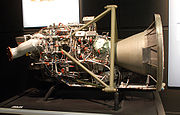
Reaction Motors XLR-99
Encyclopedia

Throttle
A throttle is the mechanism by which the flow of a fluid is managed by constriction or obstruction. An engine's power can be increased or decreased by the restriction of inlet gases , but usually decreased. The term throttle has come to refer, informally and incorrectly, to any mechanism by which...
able, restartable liquid propellant
Liquid rocket propellants
The highest specific impulse chemical rockets use liquid propellants. This type of propellant has a long history going back to the first rockets and is still in use, for example in the Space Shuttle and Ariane 5.-Early development:...
rocket engine
Rocket engine
A rocket engine, or simply "rocket", is a jet engineRocket Propulsion Elements; 7th edition- chapter 1 that uses only propellant mass for forming its high speed propulsive jet. Rocket engines are reaction engines and obtain thrust in accordance with Newton's third law...
. It was developed beginning in the 1950s by the Reaction Motors
Reaction Motors
Reaction Motors Inc. was an early American maker of liquid-fueled rocket engines, located in New Jersey. RMI engines with thrust powered the Bell X-1 rocket aircraft that first broke the sound barrier in 1947, and later successors including the X-1A, X1E, and the D558-2 Douglas Skyrocket...
Division of Thiokol Chemical Company
Thiokol
Thiokol is a U.S. corporation concerned initially with rubber and related chemicals, and later with rocket and missile propulsion systems...
to power the X-15 research aircraft. It could deliver up to 57,000 pounds force (254 kN) of thrust with an Isp
Specific impulse
Specific impulse is a way to describe the efficiency of rocket and jet engines. It represents the derivative of the impulse with respect to amount of propellant used, i.e., the thrust divided by the amount of propellant used per unit time. If the "amount" of propellant is given in terms of mass ,...
of 279 seconds (239 seconds sl). The thrust could be varied from 50 to 100 percent, and the restart capability allowed it to be shut down and restarted during flight when necessary.
The engine was propelled by liquid oxygen
Oxygen
Oxygen is the element with atomic number 8 and represented by the symbol O. Its name derives from the Greek roots ὀξύς and -γενής , because at the time of naming, it was mistakenly thought that all acids required oxygen in their composition...
and anhydrous ammonia, pumped into the engine by turbine
Turbine
A turbine is a rotary engine that extracts energy from a fluid flow and converts it into useful work.The simplest turbines have one moving part, a rotor assembly, which is a shaft or drum with blades attached. Moving fluid acts on the blades, or the blades react to the flow, so that they move and...
s at a flow rate of over 10,000 lb
Pound (mass)
The pound or pound-mass is a unit of mass used in the Imperial, United States customary and other systems of measurement...
(4,500 kg
Kilogram
The kilogram or kilogramme , also known as the kilo, is the base unit of mass in the International System of Units and is defined as being equal to the mass of the International Prototype Kilogram , which is almost exactly equal to the mass of one liter of water...
) per minute
Minute
A minute is a unit of measurement of time or of angle. The minute is a unit of time equal to 1/60th of an hour or 60 seconds. In the UTC time scale, a minute on rare occasions has 59 or 61 seconds; see leap second. The minute is not an SI unit; however, it is accepted for use with SI units...
.
After operating for one hour, the XLR99 would have to be overhauled before another usage. Operating times nearly twice that were recorded in tests, but declared largely unsafe. The basic X-15 plane carried about 83 seconds of fuel for full-powered flight, while the X-15A-2
North American X-15
The North American X-15 rocket-powered aircraft/spaceplane was part of the X-series of experimental aircraft, initiated with the Bell X-1, that were made for the USAAF/USAF, NACA/NASA, and the USN. The X-15 set speed and altitude records in the early 1960s, reaching the edge of outer space and...
carried fuel for just over 150 seconds. Therefore each XLR99 was capable, in theory, of between 20 and 40 flights before an overhaul.
Like many other liquid-fuel rocket engines, the XLR99s used regenerative cooling, in that the thrust chamber and nozzle had tubing surrounding it, through which the propellant and oxidizer passed before being combusted. This both kept the engine cool, and preheated the fuel. The basic engine itself weighs 910 lb, or 413 kg.

